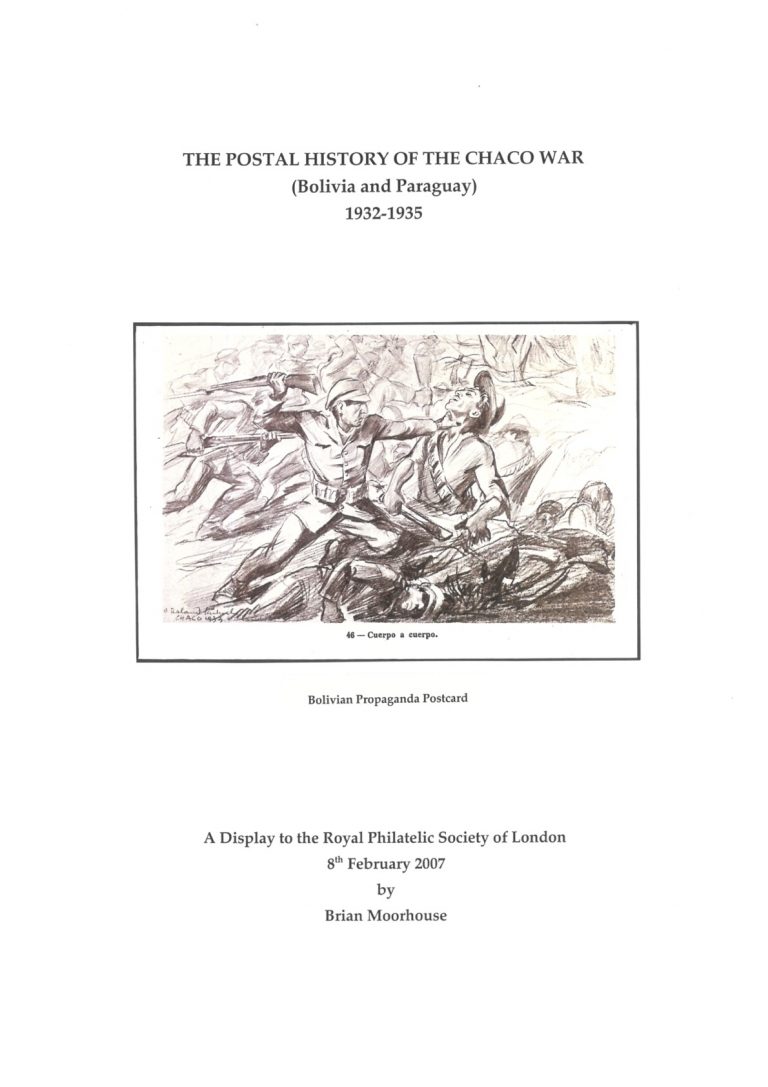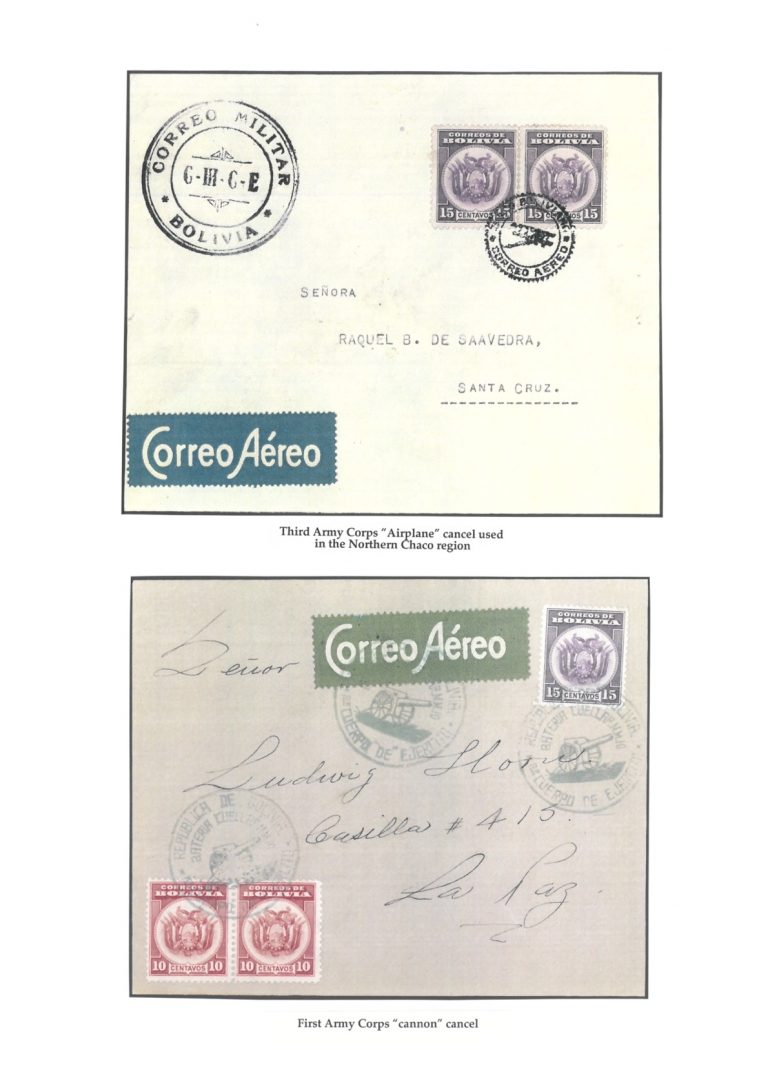Esta página solo está disponible en inglés


THE POSTAL HISTORY OF THE CHACO WAR
(Bolivia and Paraguay)
1932-1935
A Display to the Royal Philatelic Society of London
8th February 2007
by
Brian Moorhouse
Introduction
Despite the numbers of troops involved and the three year time period, covers from the conflict are relatively uncommon. The most frequently seen war-related covers are examples of handstamped military censors on civilian mails from the Bolivian side (Paraguay did not censor civilian mails during the conflict). Many of the military covers that have survived show neither dates nor originations and it is therefore very difficult to attempt to follow the course of the war with its many losses and gains for both sides from a philatelic point-of-view. This collection is therefore presented with material from the two opposing sides being shown separately and arranged by categories rather than by date order. Historical and geographical notes are included where applicable.
The following categories are included in this display
Bolivia: Military Mail, Military Telegraphs, The ‘Platanillos’ Provisional, Censor Labels, Censor Handstamps, Propaganda Postcards and ‘Timbre Patriotico’ Stamps
Paraguay: Military Mail, Censor Handstamps, Propaganda Labels and The Mennonite Colony at Colonia Fernheim
Prisoner of War mail: Mail to and from prisoners on both sides of the conflict.
This booklet is designed to be a guide to the collection being shown and each of the categories has been given its own heading. In order to make this booklet a useful reference tool, the information under some of these headings has been enlarged and contains additional detail on the particular topic in question.
A Very Brief Background and History of the War
The Chaco region is a triangular shaped area of around 300,000 square kilometers situated between Bolivia and Paraguay bounded by the Pilcomayo River on the south-west, the Paraguay River on the east and the Bolivian Plateau on the north-west. It is a very inhospitable region and, at the time of the war, was largely unpopulated apart from a few primitive Indians and an odd small farming community from the Mennonite Sect.
The ownership of the Chaco region had always been in dispute though, in 1897, President Hayes of the USA was responsible for establishing the borders that were in effect before the start of the war. The origins of the Chaco War actually date from 1924 when Bolivia, a landlocked country since the Pacific War of 1879-1883, discovered oil in the Tarija region of the country. They wished to exploit the full economic benefits by transporting it through the Chaco to the Paraguay River (navigable for large barges) and, eventually, out into the Atlantic. The first military skirmish between Bolivia and Paraguay actually took place in December 1928 and resulted in diplomatic relations between the two countries being severed. The Conference on Conciliation and Arbitration of the American Republics, at a meeting in Washington, quickly stepped in to arbitrate and a cease-fire and renewal of diplomatic relations was soon established. However, protracted negotiations failed to produce a settlement and hostilities resumed in earnest June 1932 and lasted until a final cease-fire was declared on 14 June 1935
At the outbreak Bolivia had some 100,000 trained troops and an airforce of around 50 planes. Their military forces were generally well equipped. Paraguay, on the other hand, had only around 5,000 mostly ill-equipped troops and an almost non-existent airforce consisting of just five old Fiat biplanes. The one advantage the Paraguayans did have was a small navy operating on the navigable Paraguay River.
The first major offensive was by the Bolivians who pushed deep into the Chaco region gaining a foothold on the Pilcomayo River at the south-west side of the Chaco. However, the Paraguayans, under the leadership of Jose Felix Estigarribia, halted the offensive and slowly over the following years, with many reversals of fortune, «re-conquered» the Chaco and, in fact, invaded part of Bolivia itself. lt was a bloody conflict. Apart from fighting fatalities, thousands on both sides also died from malaria, dysentery and other diseases; many also died of thirst. In all Bolivia suffered the loss of over 52,000 men plus some additional 72,000 wounded or maimed in action. On the Paraguayan side over 36,000 died and some 49,000 were wounded or maimed.
Finally, the Treaty of Buenos Aires on 21 July 1938 acknowledged most of the Paraguayan claims and three-quarters of the Chaco region was awarded to them. Bolivia was awarded the remaining part and also received navigation rights for an access to the Paraguay River.
Bolivian Military Mail
Bolivian military mau l can be considered as genuinely scarce. One reason for this is that a great majority of the soldiers were conscripts from the higher Andes regions, most of whom were illiterate, and so the actual volume of mail was relatively low compared to the actual numbers of soldiers involved in the conflict. At the outbreak of the war, in June 1932, there was no organised military postal service available for the Bolivian troops. The earliest examples of military mail that have been recorded are dated in the latter part of 1932 and it wasn’t until some time in 1933 that an organised system started to function.
Basic internal (surface mail) letters from Bolivian soldiers could be sent free of charge. However, if any supplemental services were required such as airmail or registration then these had to be paid for. Mail destined outside of Bolivia also had to be paid for in full.
lt should be mentioned that surface mail from the front lines back to the major cities of Bolivia could be a long drawn-out journey taking several weeks. There no roads in the Chaco region and ground transport had a long and arduous journey over treacherous terrain. Many of the soldiers who could write tended, therefore, to pay the requisite 30c supplement for the airmail fee to ensure that their letters were received by the addressees within a reasonable time.